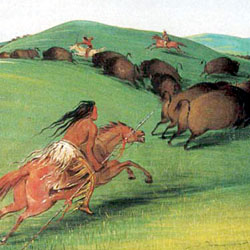
The exhibition "George Catlin and His Indian Gallery" will travel to four cities across the United States to celebrate the bicentennial of the Lewis and Clark expedition. The exhibition will be on view at The Nelson-Atkins Museum of Art in Kansas City, Missouri (February 7 - April 18); the Museum of the American West in Los Angeles (May 9 - August 4); The Museum of Fine Arts, Houston (October 10, 2004 - January 16, 2005) and the Smithsonian's National Museum of the American Indian in New York City (February 26 - August 7, 2005). The exhibition featured more than 400 objects when it premiered in September 2002 at the Smithsonian American Art Museum's Renwick Gallery in Washington DC, and was one of the largest ever organized by the museum. The tour includes highlights from the Washington exhibition, 120 paintings and artifacts.
"George Catlin and His Indian Gallery" celebrates a crown jewel in the Smithsonian American Art Museum's collection-the nearly complete surviving set of Catlin's first Indian Gallery painted in the 1830s. For the first time in more than a century, artifacts Catlin collected while in Plains Indian country are displayed next to his paintings. This exhibition is more than just the story of a single artist; it speaks to the encounter of two cultures in North America.
"Catlin's Indian Gallery is an unparalleled collection of great artistic and historic significance that contributes to understanding America's frontier and the cultures of the Native Americans who lived there," said Elizabeth Broun, the museum's Margaret and Terry Stent Director. "This exhibition conveys Catlin's regard for the rich heritage of the Plains tribes and inspires our admiration for it today."
"George Catlin and His Indian Gallery" features 106 paintings from the Smithsonian American Art Museum, two from the Smithsonian's National Portrait Gallery, one work from the Denver Art Museum and 11 Plains Indian artifacts from the Smithsonian's National Museum of Natural History. The exhibition is organized chronologically and tells the story of Catlin's epic journeys across the Plains following the Lewis and Clark trail. The exhibition and accompanying book describe, for the first time, Catlin's connections to the Smithsonian Institution.
George Catlin (1796--1872), a lawyer turned painter, decided in the 1820s that he would make it his life's work to record the life and culture of American Indians living on the Plains. In 1830, Catlin visited Gen. William Clark, governor of the Missouri Territory, superintendent of Indian affairs in St. Louis and famous co-leader of the 1804 expedition with Meriwether Lewis. Clark became Catlin's mentor, showing him his Indian museum, introducing him to the American Fur Trading Co., and taking him to visit Plains tribes. In 1832, Catlin made an epic journey that stretched over 2,000 miles along the upper Missouri River. St. Louis became Catlin's base of operations for the five trips he took between 1830 and 1836, eventually visiting 50 tribes.
"Catlin was the first major artist to travel beyond the Mississippi to record what he called the 'manners and customs' of American Indians, painting scenes and portraits from life," said Deputy Chief Curator George Gurney. "His intention was to document these native cultures before, as he feared, they were irrevocably altered by settlement of the frontier and the mass migrations forced by the Indian Removal Act of 1830."
Catlin's quest turned into a lifelong obsession that shaped his subsequent travels and the course of his life. In pursuit of his goals, this artist also became an explorer, historian, anthropologist, geologist, collector, journalist, author, lecturer and promoter. Catlin's dream was to sell his Indian Gallery to the U.S. government so that his life's work would be preserved intact. After several failed attempts to persuade various officials, he toured Europe with the collection in the 1840s, where he often featured Native Americans dancing, creating the earliest version of what would later become the Wild West show. Tragically, he was forced to sell the original Indian Gallery due to personal debts in 1852. He then spent the last 20 years of his life trying to re-create his collection.
In 1872, Catlin came to Washington, DC, at the invitation of Joseph Henry, the first secretary of the Smithsonian. Until his death later that year, Catlin worked in a studio in the Smithsonian's "Castle." A Philadelphia collector's widow, Sarah Harrison, donated the original Indian Gallery-more than 500 works-to the Smithsonian in 1879.